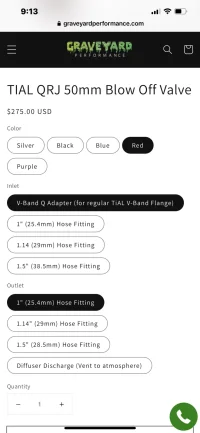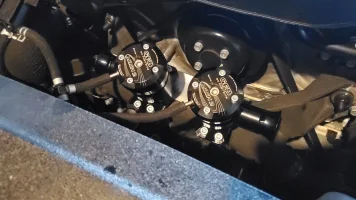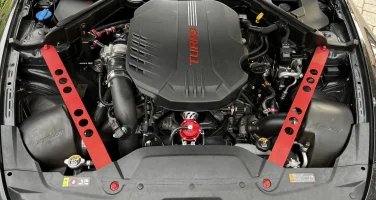Contacted Tial today I will include what they said, hopefully some one will find it useful as well.
I did notice that Tial recommended the -10 psi spring for the Q and mishimoto recommended the -6 psi.
Seems to be some confusion with the Q so I'm going with the QRJ as soon as the black one is back in stock...
We worked directly with Mishimoto during the development of that adapter, and it's designed to allow the use of either the Q, QR or QRJ, so any of them could be used. If you intend to use the BOV as an atmospheric-discharge item, than either the Q or QRJ can be used in this manner.
We prefer the QRJ for road or road/track applications, and it can support over 1000BHP worth of bypass flow, so it's certainly capable of the job. The other advantage to the QRJ is that, due to the design, it tends to have a more linear response characteristic, which lends well to FWD and AWD cars, or any car where handling is affected by throttle response. It also has a fairly unique noise signature.
The Q, as our largest BOV, is capable of supporting over 1800BHP worth of bypass flow, but due to the design, can act a bit differently on road cars, often having very sudden effects upon the handling as it opens. When it opens, it's quite loud.
With the QRJ, since it is a modular device, you'd choose the BOV based on the color and spring rating. Due to the design, we would suggest the -3psi spring for the 3.3L Stinger. Once the valve itself is chosen, you'd select the necessary adapting flanges and clamps for your adapter.
Since it can get a bit confusing, here are the part numbers you would need for a QRJ to fit the Mishimoto adapter and for a diffused outlet:
BOV: P/N varies based on color and spring (reference attached)
V-flange o-ring: 001628
V-clamp: 001624
V-flange inlet adapter: 004781
Diffuser-style outlet adapter: 004806 (Note that no adapter is 'needed' for the outlet for atmospheric discharge)
As to the question regarding the diffuser without the slots machined into it, well, those are actually 'mistakes'. There was a small run of those flanges that were produced, and the machining operation for the slots was missed. Some of them have made their way into promotional or sponsorship products, but the actual finished part is designed to, well, 'diffuse', so those slots aid in that diffusion, and are integral to that design.
For reference, no outlet adapter installed will provide the loudest noise signature from the QRJ, and, of course, if you found that to be a bit too much, the diffuser will soften it up a bit, and even then, if it needs to be quieter, you can thread in one of the available hose-type adapters and route the discharge to the airbox, which makes it fairly quiet.
Also of note; the QRJ installs with the 'side' port as the inlet, and the 'end' port as the outlet. While it is possible to install it backward, and it will still function, the design of the tapered piston and pressure chamber provide for much better response when it's installed correctly.
If you choose to use the Q BOV, you won't need to purchase any additional flanges or clamps, and you would then just select the color and spring rating. Due to the design of the Q, you would want to use a stiffer spring than with the QRJ, and I'd suggest considering the -10psi spring for that unit.
Let me know if this is helpful, and if you need a referral to order either item, just let me know where you're located and I'll try to help.
Best Regards,







